PLEN heating system: specifics of infrared film heating
Our life never stops. Technical developments that were considered new yesterday are now becoming obsolete.Heating systems are no exception. Designs with liquid coolant, once considered the only option, have long no longer satisfied the demanding consumer.
They are being replaced by many promising developments. One of them is the PLEN heating system, which has proven to be an effective way to heat a home. But what is its peculiarity and can it justify the money spent on installing film heating?
Let's look at these issues together - in our article we looked at the design of the system, its pros and cons. We also paid attention to the issue of the benefits and harms of infrared heating and separately focused on the effectiveness of PLEN in domestic conditions.
The content of the article:
What is radiant heating?
In nature, there are only three ways of heat transfer: direct heat transfer, convection and infrared radiation. Widespread in our country, and throughout the world, convective heating uses the second method for its operation.
This means that heating of the room occurs due to the movement and mixing of cold and hot air. The latter is heated by radiators.
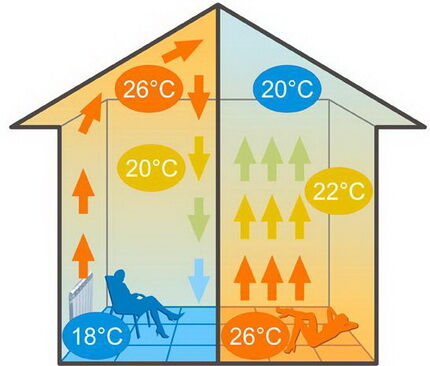
They can be heated by liquid coolant, electricity, air or any other method. The disadvantages of convective heating are significant changes in room temperature, drying out the air, and the inability to ventilate the room without heat loss.
But most importantly, it is not effective enough. The principle of convection itself involves some heat loss.
It must be admitted that the convective system copes quite well with heating buildings with insufficient thermal insulation, which is why it has become so widespread. Radiant heating works differently.
According to the laws of physics, all bodies with a temperature above absolute zero on the Kelvin scale or -273° Celsius emit infrared rays. The higher the temperature of an object, the higher the intensity of its radiation.
The transparent air environment is completely permeable to infrared waves. They easily overcome it and are absorbed only by opaque bodies. This could be walls, ceiling, floor or furniture.
When infrared rays are absorbed, objects heat up and, in turn, begin to generate infrared waves more intensely. This is how the air in the heated room is heated when an infrared heater operates.

Radiant heat very quickly warms up a room and maintains it at the desired temperature for a long time. In addition, it is better perceived by living organisms. The explanation for this is quite simple. The human body, like any other, also generates infrared waves.
Being in a room heated by convection, a person experiences a certain discomfort from the fact that only the radiators are heated.
Cool, or even cold, walls, floors and other large objects begin to “pull” infrared heat from the human body, which leads to discomfort. It's different in a room with radiant heating. Heated objects themselves emit heat and feed a person with it, so such a room is always comfortable.
All other things being equal, and even with a temperature difference in favor of a room with convective heating, a person will be more comfortable in a room with radiant heating.
For more details on the types of infrared heaters popular among users, we reviewed here.
Design of the PLEN system
The ideal source of radiant heating is a massive Russian stove. However, it cannot be installed in all rooms. Engineers have developed several types of different infrared heaters.
The most economical and effective option, perhaps, can be considered the PLEN system, which uses special film heaters for heating. It was developed by Chelyabinsk scientists relatively recently.
The name of the system stands for “film radiant electric heater.” It is this device that underlies the system. Its design is extremely simple. PLEN is a resistive radiating element laid on a foil substrate and laminated into a durable film.
The total thickness of such a heater is about 1.5 mm. Length and width may vary depending on the manufacturer.
The device uses a multilayer resistor circuit as a resistive element.When the heater is turned on, the contacts of the resistors are supplied with the power necessary to heat them up. The device heats up to 45-40 °C.
This is quite enough for the resistors to start emitting long-wave infrared radiation. It is dispersed throughout the room extremely evenly and is gradually absorbed by all opaque objects.
They, in turn, in the process of absorbing infrared waves heat up and begin to gradually release heat into the air. Practice shows that it will take 1-1.5 hours for the temperature in the room to rise by ten degrees.
Thermal insulation of the room and the correct installation of the film heater are important. If, when installing the latter, a substrate reflecting infrared waves was not placed under it, it will work less efficiently.
Once the room temperature has reached the set value, the thermostat is activated, turning off the heater. After the room has cooled down a little, it will work again and start the heater to work.
Thus, PLEN does not operate constantly, but only in periods, which makes it very economical. The quality of heating does not suffer at all: the room is maintained at the set temperature.
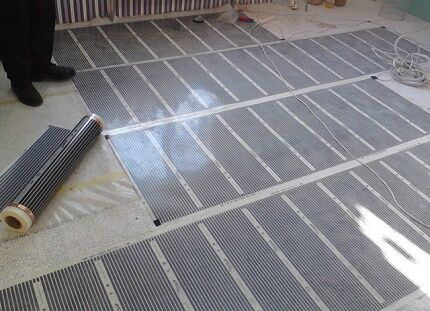
The devices are produced in the form of strips, the length of which is determined by the manufacturer. Most often it varies between 5-6 meters.
For ease of installation inside the strip, the equipment is divided into fragments that can be cut off without losing the functionality of the entire system. The width of the stripes also varies.Most often you can find models with a width of 0.5 or 1 meter.
One of the popular film systems is heating brand Zebra. We recommend that you familiarize yourself with its characteristics and operating principle in more detail.
Methods for installing film heaters
Theoretically, film-type infrared heaters can be mounted on any flat surface, oriented in almost any way. In practice, they are most often installed on the floor or ceiling.
Installation on the wall is possible, but this is the least effective option. This is explained by the fact that the heated air will rise strictly upward. Thus, the range of action of the heating device will be significantly limited.
For this reason, it is not advisable to use a wall-mounted option for heating a room, but it is quite suitable as an additional heat source.
Actually, the same models of film heaters can be used for installation on the ceiling or floor. Therefore, we will consider in more detail all the nuances of their use in one way or another.
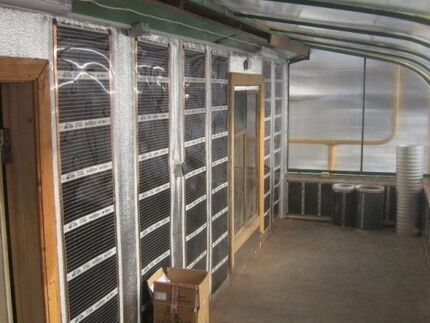
Option #1 - ceiling heating systems
Film heaters placed on the ceiling function as follows. When the system is activated, it begins to emit infrared waves that are directed straight down. The radiation moves towards the floor and is mostly absorbed by it.
The remaining waves are delayed by furniture and other large objects. As a result, all of them, including the floor, begin to accumulate and then release heat.
In full accordance with the laws of physics, the heated air begins to rise upward. Colder air masses sink lower and warm up.
Thus, it turns out that the maximum temperature in the room will be at floor level. At a height of 1.5-1.8 m it will already be 1-2ºС lower. Doctors consider this temperature distribution optimal for human health and well-being.
It must be remembered that heating is carried out as evenly as possible. Another advantage: to mask PLEN infrared heating on the ceiling, you can use almost any available coating.
The only exception here will be suspended ceilings, both fabric and film. During operation, the film heats up, and since it will be located quite close to the ceiling panel, the latter may be deformed.
However, if you really want to combine a suspended ceiling and PLEN, home craftsmen recommend installing additional protection from a layer of plasterboard. It will absorb excess heat, and the stretched fabric will remain unchanged.
Another advantage of installing film heaters on the ceiling is the low risk of accidental damage.
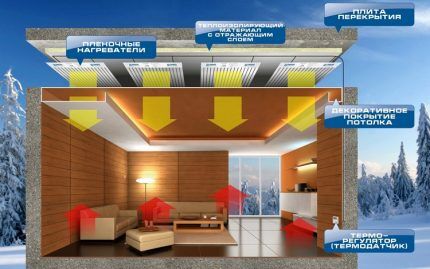
However, this is not true for apartment buildings. There is always a risk of leakage from neighbors above, in which the system will inevitably fail. The disadvantages of a ceiling system usually include complicated installation.
However, this is not true. Technically, it is no different from the floor or wall installation option. It must be admitted that it is only more inconvenient.
Another disadvantage is the impact of infrared radiation on household appliances. It cannot be said with certainty that it will lead to rapid failure of devices, but there is such a possibility. The amount of energy required to heat a room is determined by its height.
Experts do not recommend installing a film system on the ceiling of a room with a height of more than 3.5 m. Because in this case, heating costs will be too high.
Option #2 - floor placement of heaters
The film system is laid under the floor covering, which in this case can be almost anything. After turning on the heater, it quickly heats up and begins to emit infrared waves.
They rise up to the floor plane and are absorbed by the floor covering, which heats up and, in turn, begins to transfer heat to the air. Warm currents move upward and are replaced by colder ones.
As a result, the room warms up quite quickly. Despite the difference in the location of the film heaters, the temperature distribution for the ceiling and floor circuits is approximately the same.
The highest temperature will be at the surface of the floor, slightly lower - at head level. In terms of uniformity of heat distribution, both systems are also approximately the same. The main advantage of the floor-mounted option for placing heaters is the absence of direct infrared exposure to household appliances and furniture.
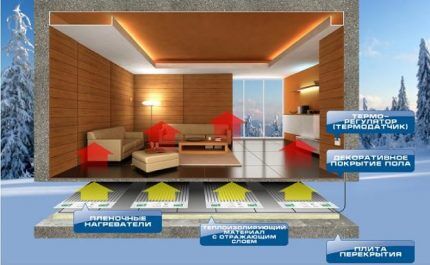
There are some features of installing film under floor coverings. As already mentioned, it can be anything. Moreover, the heaters can be installed directly into the screed. Perhaps this is one of the best options, since the film is quite vulnerable and requires careful handling.
If the coating laid over PLEN is not durable, the system can be damaged by sharp objects, bulky furniture, etc.
Therefore, it is strongly recommended to lay an additional protective film layer under thin coatings. Another feature is that an infrared film heater can overheat if large furniture or heavy household appliances are installed on top of it.
For this reason, it is better not to place film under such items, leaving the area under large items empty.
Our website contains detailed instructions for laying warm film flooring under various types of coverings and recommendations for selection and installation.
We invite you to familiarize yourself with them:
- How to make an infrared heated floor with your own hands: installation and connection of a film floor
- Warm floors under laminate: installation and installation of an infrared film system
- How to make a heated film floor under linoleum: instructions for installing an infrared heating system
- Infrared film for heated floors: types of films, how it works, installation rules
- How to make a warm floor on a balcony and loggia: choosing a heating system + installation instructions
Advantages and disadvantages of the PLEN system
Anyone who would like to install PLEN in their home is interested in learning about the advantages and disadvantages of the system.
Let's start with the advantages of installing it:
- Economical. Compared to other types of electric heating, energy costs are on average one third less. There are no operating costs required.
- Reliability and durability. Conductors sealed in film can last indefinitely. There are no moving or wearing parts in the design.
- Compact placement. Film heaters can be installed under any covering. They don't take up a lot of free space.
- System automation. This makes it possible to regulate the temperature in heated rooms and save energy.
- Versatility. The breakdown of one of the PLEN fragments does not disable the entire heating coating.
- Favorable effect on the microclimate. When the system is operating, the amount of oxygen and air humidity in the room do not change. Heat is distributed in an optimal way for a person.
In addition, you need to know that PLEN operates absolutely silently, without convection currents from air and dust. The efficiency of the system reaches almost 100%, there is no heat loss. The service life of the equipment is calculated in decades.
Most manufacturers provide a 25-year warranty, emphasizing that the system has a service life of at least 50 years. During the entire service life, film heaters do not require maintenance.

The system also has disadvantages. First of all, its installation will require sufficient electrical power and fully functional electrical wiring. Which is not always possible, especially when it comes to old houses.
In this case, you will most likely need to install new wiring, which is an additional cost. When the network voltage drops, the amount of heat generated by the film heater decreases.
True, this will not affect the room temperature in any way, since the operating time of the equipment will automatically increase. But it will affect your electricity bills.
Sometimes film heaters are fixed to the ceiling or walls without any additional finishing. It is not right. The foil on which the resistive elements are attached has high reflectivity.

This causes visual discomfort and is simply not aesthetically pleasing. Therefore, it is advisable to cover the PLEN with some kind of finishing. At the same time, you need to know that it will not work to hang wallpaper, for example, on top of a film heater.
It also cannot be painted or puttied. It is best to use any decorative covering that will need to be installed above the equipment.
Benefits or harms of infrared radiation
Most of those who are thinking about installing infrared equipment in their home have questions about the safety of such a system.
First, let's figure out what infrared radiation is. These are electromagnetic waves of a certain length. Their natural source is the Sun, which emits a large number of waves of different spectrums. The longest ones are the so-called red ones, because the human eye sees them as red.
However, scientists have proven that there are also infrared waves, the length of which is slightly longer. They belong to the waves of the spectrum invisible to humans. They get on the skin and are felt as a thermal effect. But not all infrared radiation is created equal.
Physicists distinguish three groups of such waves:
- Short, emitted by bodies with temperatures above 800 °C.
- Average. They are emitted by objects heated to 600 °C.
- Long. Emitted by bodies with temperatures up to 300 °C.
Depending on the wavelength, infrared radiation affects living organisms differently. Short waves penetrate deep enough into the human body and can warm up the internal organs.
In areas of the skin that have been exposed to short infrared waves, redness, blisters and even burns form.Medium-length waves have a milder effect, but are still undesirable for the body.
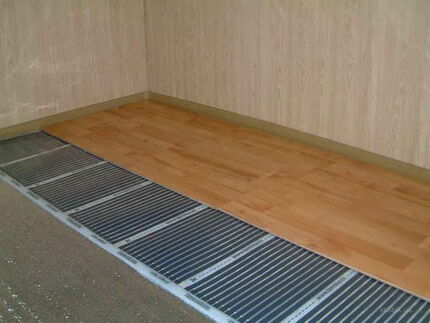
Long-wave infrared radiation is perceived by humans as pleasant warmth. It penetrates the upper layers of the skin and gently warms up the moisture in them. This is why all living organisms love to bask in the sun.
Long-wave infrared radiation not only warms, but also activates the immune system, triggers restoration and regeneration mechanisms for many systems and organs.
Considering that film equipment heats up to 45-50C, you can be sure that it emits long infrared waves. In the operating mode of maintaining the set temperature, the system operates on average from 6 to 10 minutes per hour.
Thus, it has a short-term effect on humans. The safety of PLEN is confirmed by many certificates. It is recommended for installation in medical and children's institutions.
Detailed information about the dangers of infrared heaters is discussed in our other article.
Efficient operation of film heating
The manufacturer claims that its products will work economically and efficiently. However, you need to understand that this is only true for certain conditions.
If, for example, the building is not insulated, it is at least pointless to expect effective operation from the PLEN film heating system. What requirements must be met to get the most out of infrared equipment?
One of the main ones is thorough thermal insulation of walls, doors and windows in the building.If everything is clear with the latter, then there are some nuances regarding the thermal insulation of walls.
Wall insulation should be done from the outside. For this, various materials can be used: thermal insulation followed by plastering, sandwich panels, etc. To get acquainted with the types of insulation for the walls of a house outside, go via this link.
If you insulate the walls from the inside, infrared heating will be useless.
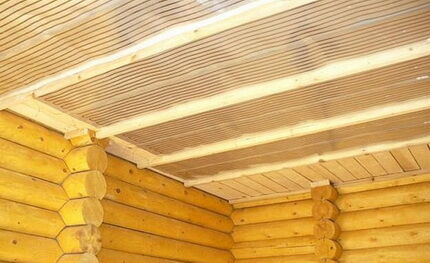
Walls covered with heat-insulating material will not accumulate or release heat, since the insulator will prevent this. To install an effective heating system, it is not necessary to completely cover the floor or ceiling with infrared film.
If it is assumed that such heating will be the main one, it is enough to cover 70-80% of the area of the ceiling or floor surface.
To arrange additional heating, it will be quite enough to cover 30-40% of the area. It is important to choose the correct mounting height for the thermostat. For the ceiling installation of the film, it should be at a height of about 1.7 m from the floor level.
For floor installation, it is raised 10-15 cm above the floor. If you make a mistake with the mounting height of the device, the system will not work correctly.
Another important point is to ensure sufficient current power for the full functioning of the system. This must be done, otherwise the efficiency of the plan will decrease significantly. To solve the problem, it will be enough to install a special load distribution unit.
The device allows you to alternately turn on different circuits of the heating system, thereby increasing the power supplied to each of them.
The film heater should be installed only on a special substrate. It has reflective properties and does not allow the base on which the film is laid to absorb infrared radiation.
It is redirected in the opposite direction, which ensures the most efficient operation of the equipment. Without such a substrate, some of the infrared waves are absorbed by the base, which leads to unnecessary energy losses.
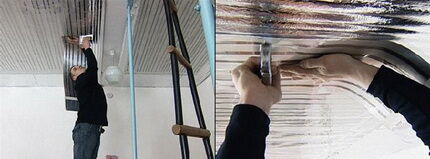
Another important point is the height of the heated room if the system is mounted on the ceiling. Standard models of film emitters are designed so that the infrared wave will travel a distance of no more than 3.5 m.
If it is larger, the radiation does not reach the floor. And, accordingly, the system will not work correctly.
Thus, if the room has high ceilings, you need to choose a floor mounting option or look for more powerful non-standard models of film heaters.
Conclusions and useful video on the topic
Main characteristics of the PLEN system:

How to install a plan under a suspended ceiling:

How to install the system under gypsum boards:

The PLEN system is a practical and very effective way to heat your house or apartment. Perhaps film heating is still unusual, but it is undoubtedly the future.
The use of infrared films will make it possible to obtain very easy-to-install, safe, efficient and economical heating.And at the same time significantly save on operation and maintenance of the system.
Have you implemented PLEN heating of a loggia or attic? Share your impressions of the result obtained - how much did the effect live up to your expectations?
Or are you just considering the possibility of installing this system and, after studying the material we offer, do you have a number of questions? Feel free to ask them in the comments to this article and we will try to help you.

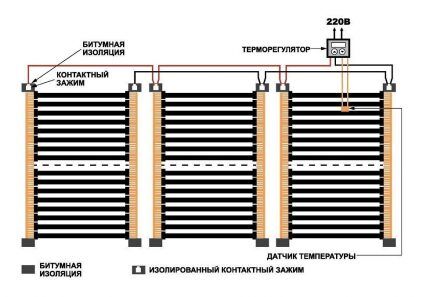




As a person who uses such a heating system, I would like to add a few pros and cons. On the positive side, it is worth mentioning the complete absence of combustion products and convection currents with this type of heating. There is no need to construct smoke exhaust systems and forced ventilation. Also, thanks to the colossal efficiency, significant savings in energy costs for heating are achieved. But there is one more disadvantage inherent to electric heaters - power outages occur hundreds of times more often than with the same gas. So there must be an alternative source of either power or heating.
In general, I agree with you, but regarding the power outage, I want to clarify that in this case, most modern gas boilers will also turn off, since their operation requires a circulation pump, also powered by electricity.
It is very ignorant of the author of the article to call all film heaters PLEN. PLEN is a trademark and a specific product produced at one single enterprise.All products are also collected under one brand, and PLEN is a brand! The author indicates the technical characteristics and operation of products, the characteristics of which are actually different! The reader receives a lot of misinformation by relying on the opinion of the author. As a result, when he goes to the market and buys, say, the cheapest Chinese heater, he will consider that he bought PLEN! Let's learn to respect other people's work! The author of the article has a fat minus for misinformation!
Please tell me what is the maximum area of heated premises with this system?
I can tell you that the PLEN heating system, in principle, can be implemented in premises of any size. But even for heating premises of 90 square meters. m, the minimum monthly electricity consumption will be 648 kW. That is, this heating method is not cheap, especially if you need to heat a room over 100 square meters. m.
In such cases, I recommend that clients for whom we install a PLEN heating system immediately do a heating project exclusively using electricity (tariffs are more loyal), plus install a two-zone day/night meter.
What I like about this heating system is that it can be implemented to suit almost any design solution.
PLEN is produced by only one plant, it is completely ignorant to put out a bunch of film heaters and call them all PLEN. Let me remind the author that PLEN is a registered trademark, you can be held liable for such an article. Most of it is complete nonsense.